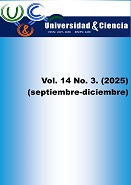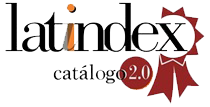Digital natives and their creativity: reflection of Logical-Mathematical Intelligence in an abstract woodcut
DOI:
https://doi.org/10.5281/zenodo.17039055Keywords:
creativity, digitalizacion, logic, mathematics, woodcutAbstract
Introduction: the study of an abstract woodcut supported the theme of digital natives and their creativity. In this way, Logical-Mathematical Intelligence was seen, within the socialization of the fable of digitalization and visual ability, as an attitude towards life. Objective: sketching actions, for the sake of woodcut visualization and deductive reasoning, framed in a dual reflection. Method: based on hyperconnectivity, being a chronological factor of integration and ingenuity, it was applied to divergent thinking. Results: the digitalizing expression, as the author of the messaging, helped with the prominence of cognitive participation and socialization demarcated creativity, as a sociocultural phenomenon, within the attitudinal development of any observer. As much as, the quantitative attitude and the systematized structure were empowered within a strategic planning. Conclusion: appealing to the method of premises, as an appendix to duality, logical reasoning was agreed upon in the existentialist theories of mental logic as complementary reasoning.
Downloads
References
Caponigro, I. (2024). Referring and quantifying without nominals: headless relative clauses across languages. Semantics and Linguistic Theory. 744-774, https://doi.org/10.3765/3dgvfv89
Chan, M. T. V., Hedrick, T. L., Egan, T. D., García, P. S., Koch, S., Purdon, P. L., Ramsay, M. A., Miller, T. E., Mcevoy, M. D. and Gan, T. J. (2020). American Society for Enhanced Recovery and Perioperative Quality Initiative Joint Consensus Statement on the Role of Neuromonitoring in Perioperative Outcomes: Electroencephalography. Anesthesia and Analgesia, 130(5). 1278-1291. https://doi.org/10.1213/ANE.0000000000004502
Coltelli, P., Barsanti, L. and Gualtieri, P. (2020). Unveiling the secrets of Escher’s lithographs. Journal of Imaging, 6(2). 119-131. https://doi.org/10.3390/jimaging6020005
Dai, Y., Lin, Z., Liu, A. and Wang, W. (2024). An embodied, analogical and disruptive approach of AI pedagogy in upper elementary education: An experimental study. British Journal of Educational Technology, 55(1). 417-434. https://doi.org/10.1111/bjet.13371
Hallett, M., Aybek, S., Dworetzky, B. A., McWhirter, L., Staab, J. P. and Stone, J. (2022). Functional neurological disorder: new subtypes and shared mechanisms. In The Lancet Neurology, 21(6). 537-550 https://doi.org/10.1016/S1474-4422(21)00422-1
Hocine, N. and Sehaba, K. (2024). A systematic review of online personalized systems for the autonomous learning of people with cognitive disabilities. Human-Computer Interaction, 39(3-4). 174-205. https://doi.org/10.1080/07370024.2023.2242364
Houlihan, B. V., Coleman, C., Kuo, D. Z., Plant, B. and Comeau, M. (2024). What Families of Children with Medical Complexity Say They Need: Humanism in Care Delivery Change. Pediatrics, 153. 51-63. https://doi.org/10.1542/peds.2023-063424F
Newton, T. (2024). Revisiting the Health System: Framing Transactional Analysis as Positive Social Psychology. Eric Berne Memorial Award Acceptance Speech. Transactional Analysis Journal, 54(1). 6-14. https://doi.org/10.1080/03621537.2023.2286573
Prem, E. (2024). Principles of digital humanism: A critical post-humanist view. Journal of Responsible Technology, 17. 266-282. https://doi.org/10.1016/j.jrt.2024.100075
Radianti, J., Majchrzak, T. A., Fromm, J. and Wohlgenannt, I. (2020). A systematic review of immersive virtual reality applications for higher education: Design elements, lessons learned and research agenda. Computers and Education, 147. 1-29. https://doi.org/10.1016/j.compedu.2019.103778
Setyadi, H. A., Supriyanta, S., Ruswanti, D. and Wahyuningsih, H. D. (2024). Profession recommendation based on multiple intelligence for high school students. Management Science Letters, 14(1). 33-42. https://doi.org/10.5267/j.msl.2023.8.001
Shchavleva, A. S. (2024). The phenomenon of the posthuman in the paradigm of modern culture. Человек и Культура, 1. 71-80. https://doi.org/10.25136/2409-8744.2024.1.40684
Ten Donkelaar, H. J. (2020). Clinical neuroanatomy: Brain circuitry and its disorders. In Clinical Neuroanatomy: Brain Circuitry and Its Disorders. 211-215. https://doi.org/10.1007/978-3-030-41878-6
Wang, H., Fu, T., Du, Y., Gao, W., Huang, K., Liu, Z., Chandak, P., Liu, S., Van Katwyk, P., Deac, A., Anandkumar, A., Bergen, K., Gomes, C. P., Ho, S., Kohli, P., Lasenby, J., Leskovec, J., Liu, T. Y., Manrai, A., … Zitnik, M. (2023). Scientific discovery in the age of artificial intelligence. In Nature, 620 (7972), 47-60. https://doi.org/10.1038/s41586-023-06221-2
Yadav, S. and Tiwari, N. (2023). Privacy preserving data sharing method for social media platforms. PLoS ONE, 18(1), e0280182. 1-14. https://doi.org/10.1371/journal.pone.0280182
Downloads
Published
How to Cite
Issue
Section
License
Copyright (c) 2025 Universidad & ciencia

This work is licensed under a Creative Commons Attribution-NonCommercial-ShareAlike 4.0 International License.





















